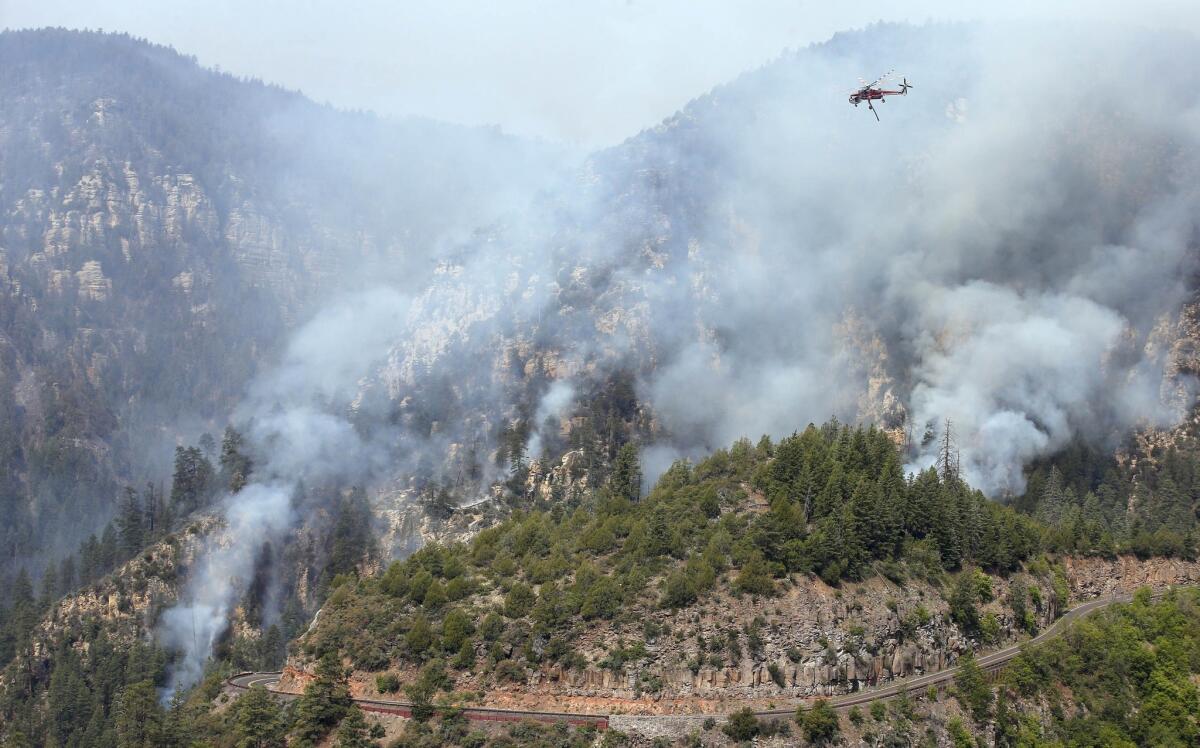Ruins revealed by Arizona’s Slide fire tell story of early settlers

- Share via
A couple of short stacks of logs that appeared to be intersecting at a right angle caught the eye of a firefighter battling the Slide fire in Arizona. An archaeologist with the crew confirmed what the firefighter suspected:
The blaze had uncovered the ruins of a cabin at least a century old.
“The finding itself was very subtle,” said Jeremy Haines, a U.S. Forest Service archaeologist. “It’s a collapsed, degraded cabin related to the earliest Euro-American settlement of this rugged, remote piece of Arizona.”
Wildfires often destroy ruins and historic artifacts. With the help of archaeologists, firefighters can sometimes protect the sites, including Native American relics across the Southwest.
But even more alluring is when a fire opens access to something previously uncharted, whether it’s a cache of arrowheads or the remains of entire villages. This week, for example, Haines found a nearly half-mile stretch of a century-old, previously unrecorded logging railroad.
The find will help archaeologists understand how far loggers ventured into the rugged terrain in the 1800s and early 1900s.
“We can see what kind of land treatments were going on in the past and what sort of technology was being used,” Haines said.
The 21,000-acre Slide fire, which was 55% contained Thursday, has been among those wildfires that give archaeologists a chance to explore terrain they otherwise could not safely reach. The fire flattened pines in a canyon between Flagstaff and Sedona, opening an unobstructed door to what local authorities describe as the world’s largest Ponderosa pine forest.
“Oak Creek Canyon was able hide for so long because there was no reason for anyone to go there,” Jason Danoff, a local hiking tour guide, said of the region’s history before the Depression.
Loggers and ranchers in the late 1800s conducted business in Flagstaff and had plenty of land with easier access than Oak Creek.
“I was shocked to hear they found a cabin in there,” Danoff said. “I’ve hiked every trail here, and I had never heard of it.”
Firefighter Leo Holley of the Coronado National Forest discovered the ruins.
“What is remarkable is that archaeological remains of the cabin were almost imperceptible,” Haines said. “Forest Service archaeologists work ... to protect these special places, and Leo’s discovery demonstrates how much we depend on firefighters to help us do this job.”
The cabin probably belonged to someone who was pushing the margins of habitable space because all the prime land is farther south, Haines said.
The cabin was probably destroyed years ago by a wildfire. The remains were found near Barney Spring. The book “Arizona Place Names” led Haines to believe that the likely cabin owner was cattle rancher Jim Barney. He had been mentioned in a letter cited in the book. Forest supervisor Ed Miller wrote in the letter, “Jim Barney ran stock west of Oak Creek in the early days. The Barney pasture and this spring where he lived were named after him.”
The cabin was probably no more than 150 square feet. The firefighting crew also found a collapsed mound of rocks, which may have been the chimney.
“Imagine you’re on horseback in a remote area 100-plus years ago; with very limited tools, you’re constructing your own living space,” Haines said.
Danoff said the cabin might have belonged to bear hunter Bear Howard. The hunter had a cabin at the front of the 13-mile canyon, Danoff said, so it would make sense to have one on the back end.
Whoever built the cabin would have had to hitch a wagon at the top of the steep canyon and hike down 2,000 feet, and probably ate elk and deer.
“It would have involved incredible resourcefulness,” Danoff said. “There would be no way to haul stuff in and out except basic supplies.”
But, he said, “To have a cabin there in Arizona would be like having an oceanfront property in California.”
The less rugged area between Sedona and Flagstaff is dotted with homes and vacation resorts that were evacuated for more than a week until residents were allowed back Thursday.
Crews covered the ruins with a fire-protection blanket. Researchers plan to date the cabin by analyzing some wood taken from the site.
“Everything in the landscape adds to our collective history,” Haines said. “What we are doing a lot is filling in the gaps.”
More to Read
Sign up for Essential California
The most important California stories and recommendations in your inbox every morning.
You may occasionally receive promotional content from the Los Angeles Times.














